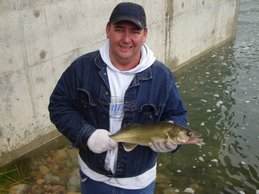Thousands and thousands of fishermen use the fly fishing technique. And they use it well. This article has some pointers for the novice fly fisherman who is just getting started in the great sport of fly fishing.
Presentation
The first thing you need to do is understand that when you cast your fly to the fish you want to present it in the most realistic manner possible. You’re trying to get the fish going here. In a stream this means a drag free float of 36 inches over a precise spot that marks the window of a feeding fish.
You never just want to cast. You always want to have a target and you always want to hit it. Practice throwing tight loops to always hit your target. You can practice overcastting and then stopping the line in mid air so that it drops right into the intended spot. In this case the fly will come back at you before falling in the water with slack in the leader.
You need to learn to fish with only 30 to 35 feet of line. This can only work however with accurate casts. You need to learn to read water so you can hit the perfect spot each and every time. You have to learn to recognize presentation and approach more than pattern.
For bass it’s a little different. The cast must move past a spot where the bass are likely to be holding. As your boat drifts it’s important to take the right time to hit the spot. If you’re too slow or too fast you will miss the fish. This is where the double haul cast can come into play. You pick 30 or 40 feet of line off the water and shoot another cast without false casting.
When bassing, make your presentation, retrieve 10 to 20 feet, pick up, and cast again without the need to false cast. After each one, drop the rod type and keep the butt of the rod near your belt buckle with the tip of the rod pointing at the line. A simple lift will let you execute the next pick up or strike a fish.
Connection Of Leaders
Any fly caster knows that a smooth connection between the leader and the fly is very important when it comes to presentation. The best way to do this is nail knot a six inch piece of 25 to 30 pound test leader line to the end of the fly line. Then both ends must have a loop in it. The same kinds of loops used on snelt hooks.
Now you want to connect the leader by passing the loop attached to the fly line through the loop on the leader, reaching through the fly line loop. Next you will take the back of the leader and pull it through until the tip passes through the loop. Now you pull the loops together by pulling both ends of the line in opposite directions.
Think Of Strategy
If you’re ever in a situation where you see large trout in the pools of water you want to start with small flies and work your way up until they start biting. Even if you got to get as big as a streamer. Typically the bigger fish will leave the smaller bait for the smaller fish and go and look for bigger things to feed on.
Dry Flies
If the best dry fly patterns are not working it may be time to switch to some different choices like spiders. Many times dry spiders will bring the fish to the surface and then you can switch back. The spiders will slowly drop to the water. Once they hit the water they usually jump around. The fish usually find this very alluring.
Dale Mazurek
Dale is a self taught professional fisherman for 35 years. He runs a fishing blog at http://fishingtutor.blogspot.com/ to help new fisherman learn the greatest sport in the world. He also runs two more very popular blogs at http://relationshiptidbits.blogspot.com/ and http://stcajo-readshortstories.blogspot.com/
Sponsors
Subscribe to:
Post Comments (Atom)




No comments:
Post a Comment